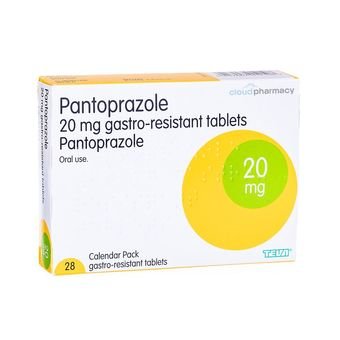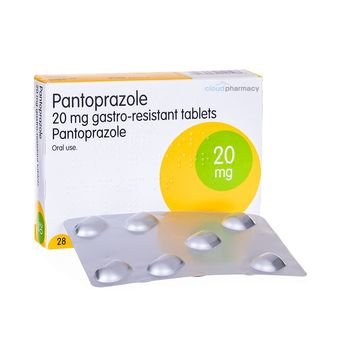Medication features
Pantoprazole is a medicine that belongs to the family of drugs known as proton pump inhibitors (PPI). It is used to treat conditions such as acid reflux, gastro-oesophageal reflux disease (GORD) and heartburn. It works by preventing certain cells within the stomach lining from producing acid. This leads to a decrease in acid refluxing up towards the respiratory tract and causing symptoms associated with all the conditions above. It is recommended that the patient take a daily dose regularly for therapeutic results to be at its most effective.
- Used to treat acid reflux and heartburn
- Provides up to 24 hours of relief
Overview
What Is Pantoprazole?
Pantoprazole is a prescription drug commonly used to treat conditions related to excess stomach acid. It can also help heal a damaged oesophagus caused by acid reflux diseases like GERD. Pantoprazole is a PPI medication. It is a class of drugs that are known as proton pump inhibitors. It relieves symptoms such as heartburn, difficulty swallowing, and persistent cough. Pantoprazole sodium is the active ingredient and is commonly sold under the brand name Protonix.
Pantoprazole is taken in the form of a tablet via the mouth. It does also come in the form of an injection and liquid mixture. So, if you struggle to swallow tablets, talk to your doctor/GP, who will be able to offer you some guidance on alternative methods.
The tablets can help you ease your symptoms within 2-3 days. The sooner you can take them, the shorter your recovery time will be.
Pantoprazole Uses
Pantoprazole treats the following conditions:
It can also be taken to treat and prevent stomach ulcers. The medication has also been used for a rare condition called Zollinger-Ellison syndrome. This is caused by the development of tumours in the gut or pancreas.
How Does Pantoprazole Work?
Pantoprazole tablets are a type of medication called a proton pump inhibitor (PPI). Proton pumps are a type of enzyme located in your stomach lining. These enzymes assist acid production, helping our body digest food. Pantoprazole tablets work by preventing these enzymes from functioning correctly. As a result, less stomach acid is produced.
Users must consume the correct dosage to allow Pantoprazole to work to its full potential. Read the product information in the medication packaging and follow your doctors' instructions. You should take one Pantoprazole tablet a day.
Pantoprazole and Alcohol
You can drink alcohol and take Pantoprazole as it does not impact its effectiveness. However, it is advised that you consult a doctor before doing so. Ideally, it would help if you approached alcohol with caution as it can increase the amount of acid your stomach produces. This worsens symptoms related to issues such as acid reflux, causing you more discomfort. Alcohol irritates your stomach lining. Talk to your doctor, who will be able to outline the risks associated with Pantoprazole and alcohol.
Is Pantoprazole Safe in Pregnancy?
If you want to treat issues like heartburn during pregnancy, Pantoprazole should be avoided. There is insufficient research to declare that Pantoprazole is safe for pregnant women. You can treat symptoms by eating smaller meals and avoiding spicy foods. If those methods do not work, consult with your doctor, who may be able to recommend an alternative treatment.
Breastfeeding mothers can take Pantoprazole tablets if their doctor/health visitor says it is safe to do so. The amount of Pantoprazole passed through breast milk is unknown. However, it is unlikely that they will experience any side effects.
Pantoprazole Alternatives
The alternatives to Pantoprazole include:
Pantoprazole vs Omeprazole
Both Pantoprazole and Omeprazole are medications that are very effective at managing acid issues and indigestion symptoms. Both of them are proton pump inhibitors (PPI). The main differences between the two come down to cost and speed.
Omeprazole works quicker than Pantoprazole. However, the effects of the medication last for a shorter length of time. This does reflect the price as Omeprazole is slightly cheaper than Pantoprazole. Additionally, the side effects of the two also differ. Pantoprazole can cause diarrhoea and headaches, while Omeprazole has a longer list of symptoms. Both medications share some similarities as both come in the form of a tablet and are also available as a liquid.
Pantoprazole vs Lansoprazole
Pantoprazole and Lansoprazole are both protein pump inhibitors effective in treating conditions related to excess stomach acids.
Both share some similarities, but they do have their differences in terms of availability and dosage. Lansoprazole is available through prescriptions and over the counter. However, Pantoprazole is prescription only. The dosage differs as Pantoprazole tablets contain 20mg or 40mg, whereas Lansoprazole tablets contain 15mg or 30mg. The side effects are also slightly different. Pantoprazole has considerably fewer side effects in comparison to Lansoprazole.
Pantoprazole Reviews
Overall, most Pantoprazole reviews are positive. Reviewers recognise that it is an effective treatment for issues such as acid reflux. Some users claim that the medication helped ease their symptoms within a few days. Another benefit that is expressed is its ease of use. As Pantoprazole is in the form of a tablet, they are easy to take.
Some reviewers did express that they encountered some mild side effects. However, the general overview is that these effects subside after a few days. Overall, Pantoprazole is recognised as an effective product for treating conditions related to excess stomach acid.
Can You Buy Pantoprazole Over the Counter?
Unfortunately, you cannot buy Pantoprazole tablets over the counter. You will need a prescription from your doctor to buy the treatment.
However, you can buy Pantoprazole tablets through Cloud Pharmacy's online pharmacy. All you need to do is complete a short online consultation beforehand. Once one of our online pharmacist prescribers has approved your consultation, the medication will be dispensed and dispatched to you in a discreet package with next-day delivery.
Directions
Side Effects
Patient Information Leaflet
Pantoprazole FAQs
Related Guides
Delve into a variety of content written by our medical experts
Pantoprazole Reviews
Confirm Pantoprazole treatment selection
| 20mg | 14 | £14.99 |
| 20mg | 28 | £19.99 |
| 40mg | 14 | £15.99 |
| 40mg | 28 | £21.99 |

















